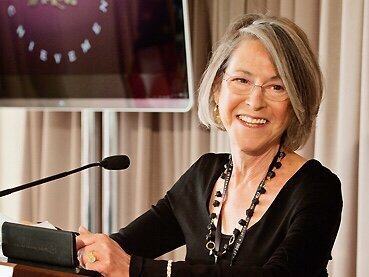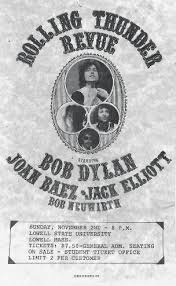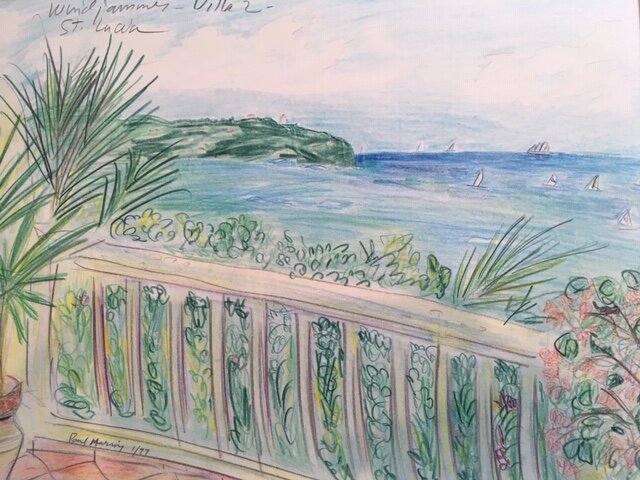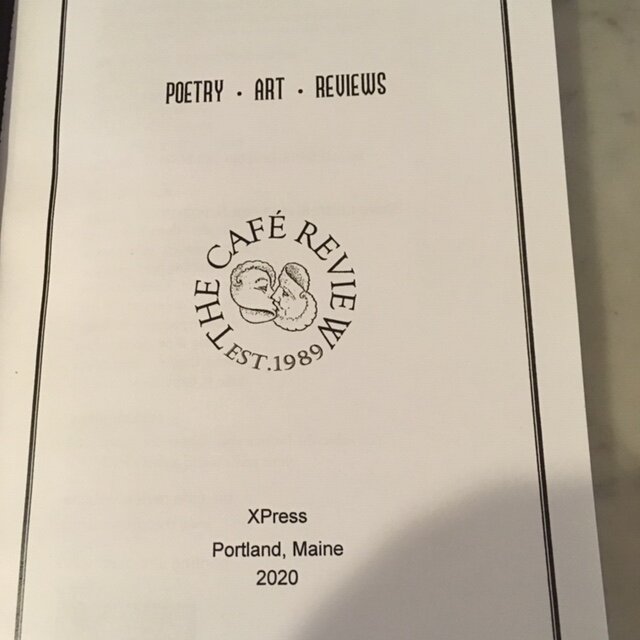Poet Louise Glück, Nobel Prize Winner
This post appeared on the popular blog RichardHowe.com on October 24, 2020
Today, we have two posts about recent Nobel Prize-recipient Louise Glück of Cambridge, Mass., who won the award in literature for her poetry. There has been a flurry of reporting about her success by media outlets in Boston, the nation, and the world. We’ve got a more personal angle. I had the great good fortune to be in a graduate writing workshop with her about forty years ago. When I learned that my former teacher had won the Nobel Prize, I asked three friends who had been with me in the MFA Program in Writing at the University of California, Irvine, to share their recollections. Dana White’s extended remembrance deserves its own post, just below, while comments by writers Juan Delgado and Shawn Levy are integrated into my longer piece about the Nobel Laureate that follows.
Dana White is a writer, editor, and a former Village Historian in Ossining, New York, where she is a Democratic candidate for the Board of Trustees (similar to a town council). We wish her good luck. She’s working on a historical novel, too.—PM
‘For Louise Glück, Poetry Was Survival’
By Dana White
WHAT WAS THE YEAR? 1983? I hadn’t been a poet long, but long enough to know that Louise Glück was one of my idols. With Plath and Sexton, she fit into a type of brilliant, complex women I imagined myself to be. Without the transcendent talent, but good enough to fall into the MFA program at the University of California, Irvine. When poet Charles Wright of the MFA program faculty announced Louise Glück would be a visiting professor, I couldn’t believe my luck.
She was tiny, and nervous. Charles Wright was very solicitous of her, almost gallant. The students were in awe. By this time, she’d published three books of poems, Firstborn, The House on Marshland, and Descending Figure. Perhaps she saw in me the same tendency to place every word just so, the short lines, the near obsession with line breaks and oblique meanings and sexually charged imagery.
Louise Glück, c. 1977 (web photo courtesy of Wikipedia/Poetrycenter.org)
As the New York Times put it recently, “It’s part of her greatness that her poems are relatively easy to access while impossible to utterly get to the bottom of. They have echoing meanings; you can tangle with them for a long time.”
As a teacher she was never cruel or sarcastic in her criticism, but encouraging of everyone, regardless of style.
One day in class she said she needed a volunteer to teach her undergraduate workshop because she had another commitment. Only two of us raised our hands. She asked us for a few poems and then chose me, saying something like she felt more of a kinship with my work. I went home and cried.
On the last day of the workshop, I asked her to sign my copy of Firstborn. She literally recoiled, saying, “That book embarrasses me. I was so young!” Yes, a youthful prodigy who drew on her inner pain to produce breathlessly beautiful poems. “But I love it,” I said, and she acquiesced. She jotted an inscription and gave it back: “For Dana, with admiration for your sharp intelligence and gusto. Not many better combinations. Warmly, Louise.”
She threw a party at her house in Laguna Beach. I remember she wore a colorful off-the-shoulder peasant blouse and served a lovely tray of tomato and fish, maybe salmon. She put on music and danced and flirted, which surprised me, since her poems denoted someone who sat around all day smoking cigarettes and wearing black. Her poems were dark and stark, but she clearly relished life.
I didn’t stay a poet long enough to have early work to be embarrassed by. The poetic muse deserted me, though I enjoyed the entanglement while it lasted.
The summer before entering the MFA program at UCI, I interned at a big newspaper in Southern California. While there I dated, quite briefly, a reporter who told me, “Poetry always struck me as a parlor trick.” Perhaps he was right. For me it was. For Louise Glück, I believed, poetry was survival.
I ended up a journalist of sorts. But over subsequent decades, every time Louise Glück released a new book, I bought it, and read it. These volumes occupy an entire shelf in my library, a testament to one who survived.
And now I can say when I was twenty I sat in as a teacher for a remarkable poet who went on to win the Nobel Prize forty years later. Which is something, I guess.
Web photo courtesy of achievement.org (American Academy of Achievement)
Louise Glück Wins One for the Home Team
by Paul Marion
WHEN THE WORD CAME DOWN that Louise Glück had been awarded the Nobel Prize in Literature, Jack Mitchell, conductor of the Lowell Live Feed chat-page orchestra on Facebook, asked me to write something for the civilians who may not know this writer. Jack said he always roots for the home team and was pumped about the global announcement. In the moment, I dashed off a long paragraph with basics, but there’s more to say.
Which American poet is a household name, living poet that is? Robert Frost left the Earth in 1963. Famous Seamus Heaney, a Nobelist, taught in Cambridge, at Harvard, but he’s Irish. The inaugural poets of presidents Bill Clinton and Barack Obama have drained from the headlines—the exception being the late Maya Angelou. But now we have a bonafide Massachusetts person getting this grand prize, same one that Bob Dylan earned a couple of years ago. People new to this author start with her name, the two-dot umlaut over the second “u” like a speed bump slowing down the uninitiated. How do you say that? It’s Glück like “Glick.”
This news is special for Massachusetts and New England, places with strong connections to the poet over decades. The selection committee praised her poems whose “austere beauty makes individual existence universal.”
As it happens, I studied with her for a term in the master of fine arts program in writing at the University of California, Irvine, in the mid-1980s. In class, she paid close attention to the student work and made constructive comments. Beyond her award-winning writing, she has been an inspiring teacher to a legion of upcoming writers. At Irvine I tested myself in a professional setting and came away encouraged to keep going after being in workshops with her and another poet, Garrett Hongo (The Mirror Diary: Selected Essays, 2017; Coral Road, 2011).
Many recent media reports mention Louise Glück’s passion for teaching. It’s not a one-way deal. She speaks about what she’s gained from the years of working with emerging writers. She has judged manuscript contests, served on prize committees, and nurtured writers who have made a serious mark in the culture. Her latest collection of prose, American Originality (2017), includes a group of essays introducing books by young poets. Few established authors would use pages in a book of theirs to give this visibility to writers coming up the ladder. It says a lot about her kindness.
I asked three of my workshop comrades to send their initial reactions to the prize news.
Shawn Levy of Oregon is a film critic and author of many books including his latest: The Castle on Sunset: Life, Death, Love, Art, and Scandal at Hollywood’s Chateau Marmont (2019). He recalls Louise Glück’s energy, joy, and generosity. “She was tiny but spry and could alternate between intense focus and absolutely crackling interest, engagement, participation.”
The sound of a composition and its architecture are integral to a well-made poem, one that can bring a reader back time and again.
One of her teaching methods was to require students to memorize a poem and recite it—to put the poem in the air and in everyone’s ears. One of my poems was “Blackberry Eating” by Galway Kinnell ( “. . . the ripest berries/ fall almost unbidden to my tongue,/as words sometimes do, certain peculiar words/like strengths and squinched, / many-lettered, one-syllabled lumps,/ . . .”). Shawn brought John Berryman to the table with one of The Dream Songs. Juan Delgado (see more below) offered Langston Hughes’ “Little Lyric of Great Importance”: “I wish the rent/Was heaven sent,” and got busted for brevity. He gave us another poem the next week.
She lived outside of Irvine and spent full days on campus when her classes were on. “Always open and available, she kept lengthy office hours,” Shawn says, which the writers in the program appreciated immensely.
As Dana White mentions in the essay above, Shawn also remarks on her liveliness. “You wouldn’t necessarily know it from her poems,” he says, “but she loved to laugh and chat and even–at a daytime potluck lunch party at someone’s house in Los Angeles–dance, about which we all gossiped astonishedly later.”
Juan Delgado lives in Southern California, where he taught for many years at California State University, San Bernardino. A poet with several books to his name (Vital Signs, 2013) and an innovative visual artist, Juan remembers Louise Glück saying that poets are writing a single poem throughout their lives. “She advised us to collect fragments, passages, and lines as a way to find insightful ways to construct poems.”
Sometimes the small particulars of memory are most revealing or at least most intriguing. “One day in the workshop she went around the room asking us to name two things that we loved. When it was her turn she said she loved American soap operas and Neil Young. We didn’t ask her which soap operas she watched.”
Juan’s remembers her attending a literature seminar on James Joyce’s Ulysses taught by poet James McMichael. She would just show up. “A couple of times she sat next to me,” Juan says. “After one long discussion about narrative, she leaned towards me and whispered, ‘Jamesy, what a nut.'”
This Nobel Prize puts her in legendary company of poets from our region and state, especially the women writers, from the first notable poet in America, Anne Bradstreet of North Andover, to Phyllis Wheatley of Boston, first African-American poet in the nation; from Emily Dickinson, the incomparable, to the under-appreciated Lucy Larcom, poet, memoirist, and abolitionist with Lowell links; and then later Elizabeth Bishop, Sylvia Plath, Anne Sexton, Maxine Kumin, Marge Piercy, and Adrienne Rich, as well as the very popular Mary Oliver.
It’s worth noting that several major poets of the modern era, white men, in Massachusetts and New England whom we think of as top-tier are not Nobel laureates: Robert Frost, Wallace Stevens, and Robert Lowell, for example. T. S. Eliot, who won the Nobel in 1948, touches Harvard University and Cape Ann on the north shore of our state, but he’s from St. Louis and moved to England. Who would be a contender in the region today? Again, among men. Charles Simic, perhaps, in New Hampshire. Martin Espada, long-time faculty member at UMass, is still building his body of work. Robert Pinsky has a strong record as an engaged poet and has been the national poet laureate. Now, women writers and writers of color are ascendant in American poetry. Rita Dove, Claudia Rankine, Joy Harjo, Tracy K. Smith, Natasha Trethewey, Jorie Graham, Juan Felipe Herrera, Jericho Brown, Ocean Vuong, Terrance Hayes, Kevin Young.
Louise Glück writes beautifully about the natural world and goes deep into the interior, where it can be dark, as she makes sense of the human condition. The poems are often informed by classical myths and religious sources. She bridges the time gap, writing about contemporary life in the context of ages-old experience.
My friend John Suiter in Chicago tells a story about pitching a big-time literary agent in New York City for a book he proposed to write about Gary Snyder and other poets. The agent said, “I don’t know Snyder.” John pointed out that Snyder had won the Pulitzer Prize some years before. The agent asked John, “Do you know who won the Pulitzer for poetry this year?” John didn’t have the name at his fingertips. “Louise Glück,” the agent replied, adding, “These people are a dime a dozen.” Well, the Nobel Prize in Literature is not a dime a dozen.
Louise Glück has been a poet’s poet with a substantial readership, and now, I hope, she will break through the pop culture noise to gain an even larger audience. She told the New York Times that she’d prefer not to become as popular as Henry Wadsworth Longfellow in the nineteenth century, concerned for what that might mean about the depth of her art.
It’s not “easy” poetry even if it looks that way on first encounter, but if people give her writing a try they can find something of lasting value, a fresh insight or memorable observation, a sliver of light in the night, or as Robert Frost said, “a momentary stay against confusion.”
Here’s a poem from the collection Averno by Louise Glück, which was published in 2006.
The Night Migrations
This is the moment when you see again
the red berries of the mountain ash
and in the dark sky
the birds’ night migrations.
It grieves me to think
the dead won’t see them—
these things we depend on,
they disappear.
What will the soul do for solace then?
I tell myself maybe it won’t need
these pleasures anymore;
maybe just not being is simply enough,
hard as that is to imagine.











![“Lowell State University” [wrong name] concert flier; Joan Baez and Bob Dylan, 1975](https://images.squarespace-cdn.com/content/v1/571d2a1460b5e99d45a5d739/1600092842207-4N2P3QKRC3FDU1ZK98Z0/dylan+baez+1975+lowell.jpg)

































